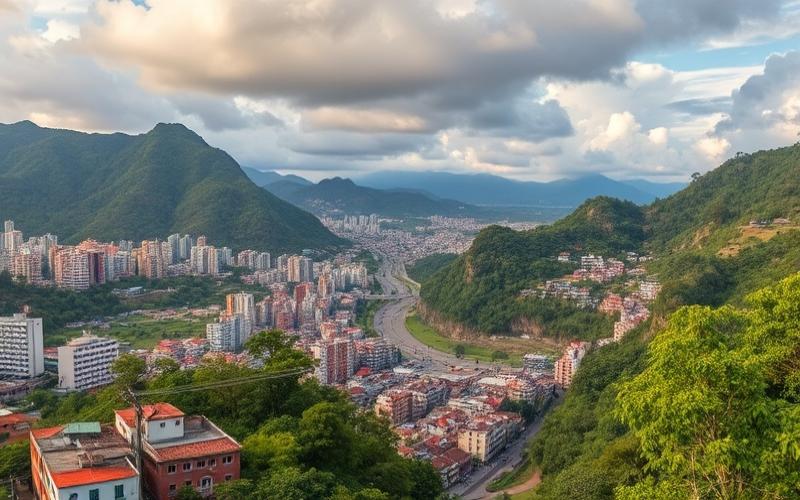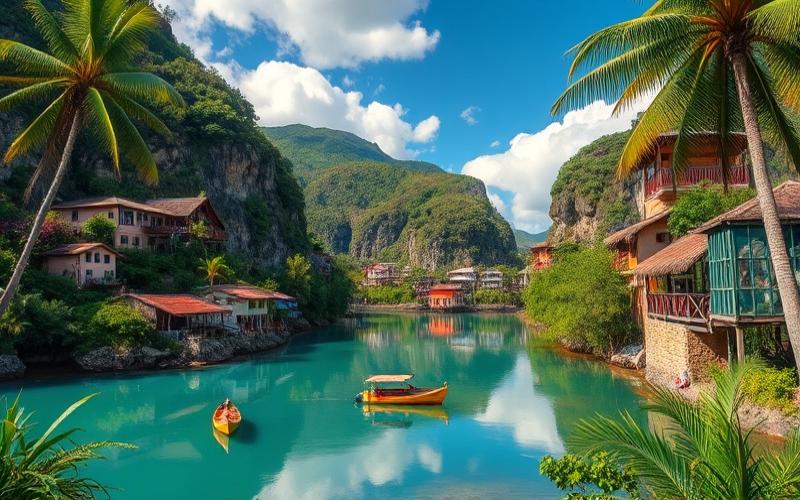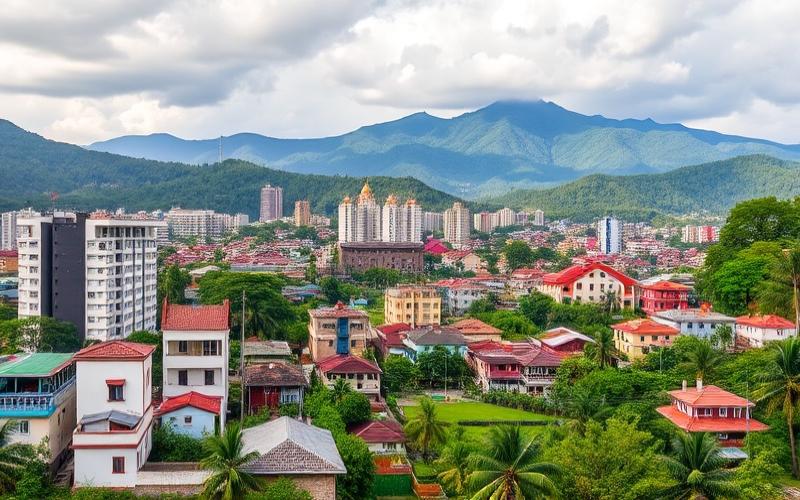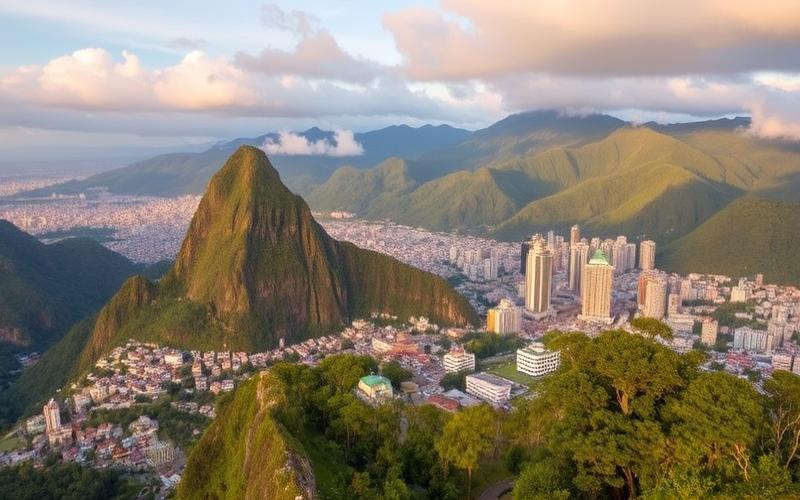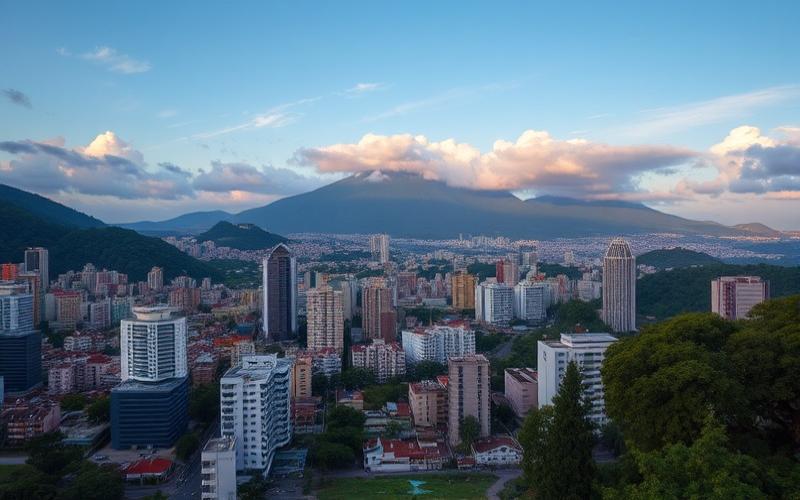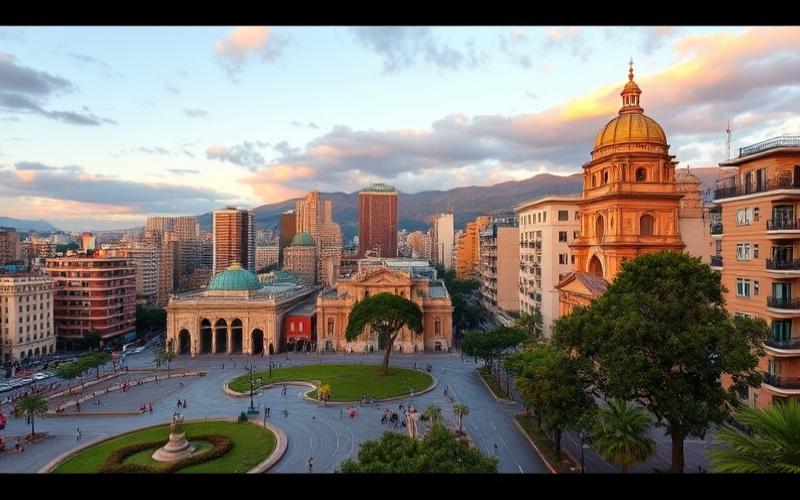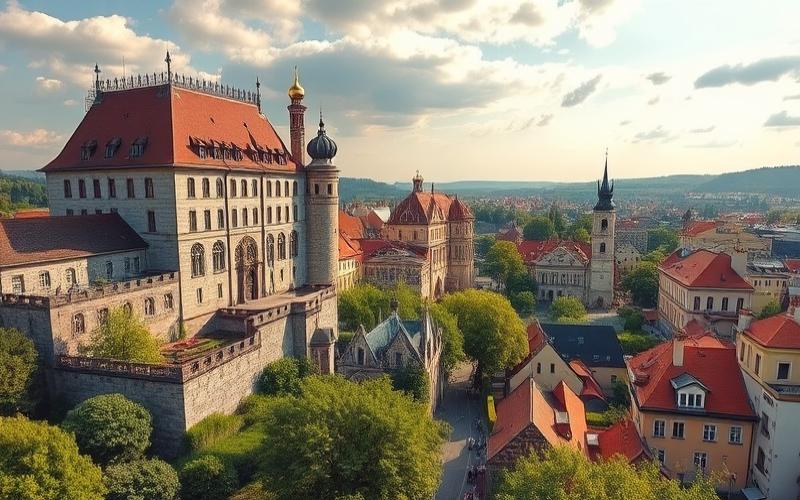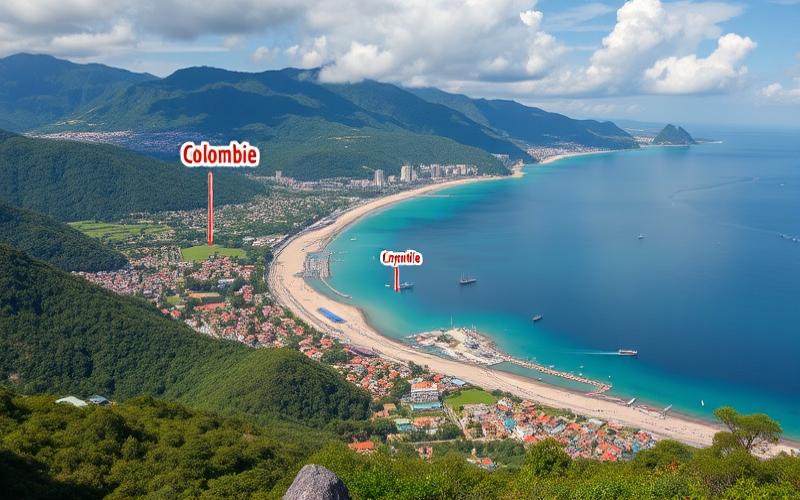
 Published on and written by Cyril Jarnias
Published on and written by Cyril Jarnias
Diving into Colombia means embarking on a rich and varied culinary journey where every bite tells a story.
Whether you’re seeking the vibrant aromas of the Andes, the tropical flavors of the Caribbean Coast, or the unique fusion of Bogota, this article is your guide to navigating a world of taste discoveries.
Whether you’re an expatriate eager to understand your new environment through its cuisine or simply a taste adventurer, get ready to explore the spicy and colorful diversity of this surprising country.
Diving into Colombian Cuisine: Local Specialties and Their Cultural Importance
Arepa
Main Ingredients: cornmeal, water, salt. Depending on the region, they can be filled with cheese, meat, eggs, beans, or avocado.
Preparation Techniques: the dough is shaped into patties and then pan-cooked, grilled, or sometimes fried.
Regional Variations
- Arepa de choclo (sweet corn, Andes)
- Arepa de huevo (egg-filled, Caribbean)
- Arepa boyacense (with cheese, Boyacá)
Cultural Role: a staple of daily meals, from breakfast to dinner. It accompanies all meals and symbolizes Colombian culinary identity. Local festivals, like the Arepa Festival in Antioquia, pay tribute to it.
Bandeja Paisa
| Main Ingredients | Role in the Dish |
|---|---|
| Rice | Energy base |
| Red beans | Plant-based protein source |
| Various meats | (ground beef, chorizo, chicharrón) |
| Fried egg | Protein complement |
| Fried plantain | Sweet and energetic note |
| Avocado | Freshness and creaminess |
| Arepa | Traditional side |
| Hogao (tomato-onion sauce) | Accompaniment sauce |
Preparation: each component is prepared separately and generously arranged on a large plate.
Regional Variations: originally from Antioquia, but adapted throughout the country with substitutions based on local products.
Cultural Importance: considered the national dish, often shared during large family gatherings or celebrations. It embodies the generosity and abundance of the paisa culture.
Ajiaco
Main Ingredients: chicken pieces, three types of potatoes (criolla, sabanera, pastusa), corn on the cob, guasca aromatic herb.
Preparation Techniques: slow cooking of ingredients in broth, adding guasca for the characteristic flavor.
Served with: cream, capers, avocado, white rice on the side.
Regional Variations: typical of Bogotá and the Andean region, the proportion of potatoes and herbs may vary.
Cultural Role: festive and family dish, highly appreciated during national holidays or gatherings. A symbol of the capital, it expresses the agricultural diversity of the region.
Sancocho
Main Ingredients: meat pieces (chicken, beef, or fish depending on the region), cassava, potatoes, corn, plantain, cilantro.
Preparation Techniques: cooking all ingredients in a large broth flavored with herbs.
Regional Variations
- Sancocho de gallina (chicken, Andes)
- Sancocho de pescado (fish, Caribbean and Pacific coasts)
- Sancocho trifásico (mix of several meats)
Cultural Role: convivial dish served during parties, picnics, or family Sundays. It symbolizes sharing and Colombian hospitality.
Cultural Influences
- Indigenous: use of corn (arepa), potatoes, cassava, and local herbs like guasca.
- African: frying techniques (plantain, chicharrón), use of coconut on the coasts, mix of sweet and savory flavors.
- Spanish: introduction of beef, pork, rice, as well as the tradition of saucy dishes and hearty meals.
Authentic Culinary Experience: Must-Visit Places
- Bogotá: tasting ajiaco at La Puerta Falsa restaurant, a century-old institution near Bolívar Square.
- Medellín: bandeja paisa at Hacienda Junin or Mondongos, renowned for their regional cuisine.
- Cartagena and Caribbean region: arepa de huevo at local markets or sancocho de pescado by the sea.
- Boyacá: arepas boyacenses and ajiaco in traditional villages.
Colombian cuisine is a mirror of the country’s cultural diversity, where each dish tells a story of blending, sharing, and attachment to traditions.
Good to Know:
The endlessly varied “arepas” are perfect at Bogotá’s Paloquemao market, while the “bandeja paisa” reaches its peak in Medellín, reflecting the country’s rich Afro-Hispanic and indigenous cultural heritage. Explore family-style ajiaco in Bogotá or savor a comforting sancocho by the river in Cali for a total immersion in Colombian tradition.
Traditional Markets and Iconic Restaurants: Where to Satisfy Your Palate
Renowned Local Food Markets
- Paloquemao in Bogotá
- A true local institution, this market offers a great diversity of flowers, exotic fruits, vegetables, meats, fish, dairy products, and herbs every day.
- The stalls are bursting with colors and scents: mangoes, papayas, zapotes, guanábanas, passion fruits, dragon fruits, lulos, as well as an impressive selection of Colombian flowers.
- It’s possible to taste specialties on-site like arepas, empanadas, almojábanas, or to enjoy a typical Colombian coffee.
- The experience is sensory and immersive, allowing you to taste tropical fruits rarely seen elsewhere and interact with local vendors.
- Bazurto in Cartagena
- A traditional, lively, and non-touristy market, the heart of daily life for Cartageneros.
- You’ll find an abundance of fresh fish, seafood, meats, tropical fruits, vegetables, spices, and crafts.
- The atmosphere is warm, authentic, and vibrant. Visitors can taste typical dishes prepared on-site or have breakfast in the market’s dining area.
- The market offers a dive into Cartagena’s popular culture, far from the usual tourist circuits.
| Market | Key Products | Culinary Experiences |
|---|---|---|
| Paloquemao | Exotic fruits, flowers, meats, fish, coffee | Tasting local specialties, coffee, tropical fruit juices |
| Bazurto | Fish, seafood, tropical fruits, spices | Discovering typical dishes, immersion in local life |
Iconic Restaurants
- Andrés Carne de Res (Chía, near Bogotá)
- A festive institution known for its unique ambiance and eccentric decor.
- Menu highlighting Colombian cuisine classics: bandeja paisa, arepas, chorizos, empanadas, churrasco, and other grilled meats.
- A complete culinary and cultural experience thanks to shows, live music, and a friendly atmosphere.
- Tips: the restaurant is very popular, it’s recommended to reserve in advance, especially on evenings and weekends.
- Leo (Bogotá)
- An internationally recognized gourmet restaurant, led by chef Leonor Espinosa.
- Innovative cuisine highlighting local ingredients and revisited traditional recipes: ajiaco, sancocho, Amazonian ceviches, preparations with indigenous tubers and plants.
- The establishment offers a culinary experience centered on Colombian biodiversity and its terroirs.
- Tips: reservation strongly advised, fixed evening hours, appropriate attire recommended.
| Restaurant | Specialties Offered | Reasons to Go | Practical Tips |
|---|---|---|---|
| Andrés Carne de Res | Bandeja paisa, grilled meats, arepas | Festive atmosphere, popular culture | Reservation recommended |
| Leo | Ajiaco, sancocho, fusion cuisine | Innovative gastronomy, local products | Reservation required, high-end experience |
Traditional Dishes Not to Miss
- Ajiaco: typical Bogotá soup with chicken, potatoes, corn, guasca, and cream.
- Bandeja paisa: iconic Antioquia dish with rice, red beans, ground meat, chorizo, pork rind, egg, avocado, and plantain.
- Sancocho: Colombian stew, often with meat (chicken, beef, fish), vegetables, and local tubers.
Practical Tips for Expatriates
Traditional markets, like Paloquemao and Bazurto, generally open very early (often from 5 or 6 a.m.) and close in the early afternoon. Hours are flexible, but it’s advisable to visit in the morning to enjoy the freshness of the products and the lively atmosphere.
In renowned restaurants, it’s better to reserve in advance, especially in the evening and on weekends.
For a complete immersion, opt for guided tours or go accompanied by a local to discover lesser-known products and specialties.
It’s common to pay in cash at traditional markets, so have small change ready.
Good to Know:
Explore Paloquemao market in Bogotá to discover an impressive variety of tropical fruits, or head to Bazurto in Cartagena for a unique culinary immersion; don’t forget to reserve in advance at iconic places like Andrés Carne de Res in Chía or Leo in Bogotá, where you can taste specialties such as ajiaco or bandeja paisa.
Culinary Etiquette in Colombia: Tips for Adapting to Cultural Contexts
In Colombia, culinary etiquette reflects both conviviality and respect for traditions, with habits that vary by region but share a keen sense of courtesy and shared pleasure around the table.
List of Main Cultural Habits Surrounding Meals:
- Respect for Schedules: Lunch (almuerzo), generally served between 12 p.m. and 2 p.m., is the most important meal of the day. Colombians place great value on this moment, often shared with family or colleagues.
- Importance of Lunch: It’s a complete meal, often consisting of a soup, a hearty main course, a drink, and sometimes dessert.
- Sobremesa: After the meal, it’s common to extend the conviviality with conversation, coffee, or a small treat. This tradition, called “sobremesa,” is a privileged moment to strengthen social bonds.
Manners to Respect During Meals:
- Wait for the Host’s Invitation: It’s frowned upon to start eating before the host has invited everyone to do so.
- Compliment the Cooking: Thanking and complimenting the person who cooked is not only appreciated but expected.
- Sharing and Generosity: When a dish is offered at the table, it’s appropriate to serve yourself moderately so everyone can taste.
- Use of Utensils: Utensils are used for most dishes, but some foods like arepas or patacones can be eaten with hands.
- Bring a Gift: If you’re invited to someone’s home, it’s good manners to bring a small gift: a bottle, pastries or dessert, or even flowers.
- Offer a Contribution: Depending on closeness with the hosts, it’s common to offer to bring a dish or drink to share.
Table of Regional Specificities and Notable Differences:
| Region | Culinary Specificities | Etiquette Particularities |
|---|---|---|
| Antioquia | Bandeja paisa, arepas, frijoles | Very hearty meals, shared with family |
| Caribbean Coast | Arepas de huevo, ceviche | Lighter meals, relaxed atmosphere |
| Andean Region | Ajiaco, changua | Importance of hot breakfast |
| Tolima | Lechona (stuffed pork) | Large gatherings during festivals |
Tips for Expatriates to Avoid Faux Pas:
- Observe Before Acting: Take time to watch how other guests do things before starting to eat or serve yourself.
- Express Gratitude: A simple “¡Qué rico!” or “Muchas gracias” to the cook is always welcome.
- Be Punctual: Arrive at the agreed time, but a slight delay (5-10 minutes) is tolerated in informal settings.
- Respect Regional Diversity: What’s customary in Medellín may be different in Cartagena; adapt to the local context.
- Participate in the Sobremesa: Even if you’re not a big talker, staying a while after the meal over coffee is appreciated.
- Avoid Criticism: Unless invited to do so, avoid comparing local cuisine to that of your home country.
To integrate quickly, it’s enough to show curiosity, respect, and good humor around the table.
Good to Know:
Wait for the host to invite you to start eating and take time to compliment the cooking to show your appreciation; during shared meals, it’s common to bring a dessert or drink. To avoid faux pas, be punctual for lunch, which is the main meal, and participate in the sobremesa by staying a few moments to chat after the meal.
Exploring International Cuisine: Finding Foreign Ingredients in Colombia
In Colombia, access to foreign ingredients has significantly developed thanks to the presence of large supermarkets, specialty grocery stores, and online platforms. Expatriates and international cuisine enthusiasts can thus diversify their diet while integrating into the local culinary scene.
| Type of Store | Examples of Chains or Addresses | Specialties / Common Foreign Products |
|---|---|---|
| International Supermarkets | Carulla, Éxito, Jumbo | “Ethnic” section: Asian sauces (La Choy, Lee Kum Kee), Indian condiments (Patak’s), Mexican products (Old El Paso), Italian pasta (Barilla), olive oils, American products (Campbell’s, Del Monte) |
| Asian Grocery Stores | Mercatus 9 (Bogotá), Mecatus 9 | Chinese, Japanese, Korean, Thai products (sauces, noodles, dumplings, specific spices) |
| Specialty Grocery Stores/Importers | Tiendas Gourmet, organic grocery stores, markets in expatriate neighborhoods | European cheeses, rare spices, pasta, sauces, condiments, French and Italian products |
| Local Markets | Paloquemao (Bogotá), traditional markets | Some stalls with exotic ingredients, fresh herbs, seasonal imported products |
| Online Platforms | Mercatus 9 (online), Rappi, Cornershop, expatriate Facebook groups | Ordering foreign products, home delivery, community recommendations |
Access to Food Products from Other Cultures:
The “ethnic” aisles in Carulla or Jumbo supermarkets offer a growing choice: soy sauces, curry, tortillas, Italian pasta, couscous, olive oil, American and French products.
Asian grocery stores in Bogotá (e.g., Mercatus 9) provide a wide range of Japanese, Chinese, Korean, or Thai ingredients, suitable for traditional or fusion recipes.
Mexican products are easy to find (tortillas, sauces, black beans, condiments) through American or local brands.
Integration and Culinary Diversity for Expatriates:
Many expatriates adopt a dual approach: learning to cook Colombian while adapting their favorite recipes using imported ingredients.
Local markets allow discovery of fresh Colombian products that can replace or enrich international recipes (e.g., using arepa as a base for open sandwiches, integrating exotic fruits into European desserts).
Some expatriates recommend testing local alternatives when an ingredient is hard to find (e.g., replacing fresh cilantro with guasca, using costeño cheese for Mediterranean dishes).
Useful Platforms and Communities:
Facebook groups like “Expats in Colombia,” “Foodies Bogotá,” or “Asiáticos en Colombia” are excellent sources of tips and addresses, often updated.
Online delivery platforms (Rappi, Cornershop) list many specialty grocery stores and allow receiving international products at home.
Expatriates often exchange advice on WhatsApp or Telegram, sharing their “good deals” for finding rare products or organizing group orders.
Anecdotes and Practical Tips from Expatriates:
“For my curry, I order coconut milk and curry paste on Mercatus 9, but I’ve replaced kaffir lime leaves with local lime zest, it works great!”
“Barilla pasta is everywhere, but for Italian spices or charcuterie, you need to go to Carulla or a tienda gourmet.”
“I discovered Chinese dumplings in an Asian grocery store in Chapinero and now even my Colombian friends love them.”
“Expat Facebook groups helped me find an artisanal cheese shop that offers brie and camembert.”
Practical Tips:
- Anticipate certain purchases during holidays (Christmas, New Year), when stores import more European and American products.
- Test local recipes and dare culinary fusions: a ceviche revisited with Asian spices, or arepas filled Italian-style.
- Keep an open mind: the Colombian culinary scene is evolving rapidly, with new addresses and products appearing regularly.
Opening up to local gastronomy while maintaining a link with one’s origins is not only possible but enriching thanks to the growing diversity of ingredients available in Colombia.
Good to Know:
Expatriates in Colombia can explore international cuisine by visiting specialty grocery stores like Carulla for Italian pasta, Jumbo supermarkets for Mexican condiments, or going to Paloquemao Plaza in Bogotá for a variety of Asian spices. Additionally, online platforms or expatriate groups on Facebook prove useful for exchanging addresses or tips on buying rare ingredients.
Disclaimer: The information provided on this website is for informational purposes only and does not constitute financial, legal, or professional advice. We encourage you to consult qualified experts before making any investment, real estate, or expatriation decisions. Although we strive to maintain up-to-date and accurate information, we do not guarantee the completeness, accuracy, or timeliness of the proposed content. As investment and expatriation involve risks, we disclaim any liability for potential losses or damages arising from the use of this site. Your use of this site confirms your acceptance of these terms and your understanding of the associated risks.





